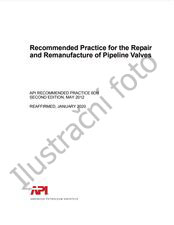Potřebujeme váš souhlas k využití jednotlivých dat, aby se vám mimo jiné mohly ukazovat informace týkající se vašich zájmů. Souhlas udělíte kliknutím na tlačítko „OK“.

API RP 580-ed.4
Elements of a Risk-Based Inspection Program
Přeložit název
NORMA vydána dne 1.8.2023
Informace o normě:
Označení normy: API RP 580-ed.4
Datum vydání normy: 1.8.2023
Kód zboží: NS-1153945
Počet stran: 99
Přibližná hmotnost: 328 g (0.72 liber)
Země: Americká technická norma
Kategorie: Technické normy API
Anotace textu normy API RP 580-ed.4 :
API RP 580, 4th Edition, August 2023 - Elements of a Risk-Based Inspection Program
Industry Scope
This RP is specifically targeted to the application of RBI in the hydrocarbon and chemical process industries. The principles and concepts herein can be applied in other industries with appropriate documentation.
Purpose
The purpose of this RP is to provide users with the recommended elements for developing, implementing, and maintaining an RBI program. This RP provides guidelines for establishing an RBI program which when implemented properly, will allow the owner-operator to integrate risk assessment and inspection planning into an existing inspection program. The approach emphasizes safe and reliable operation through risk-prioritized inspection. A spectrum of complementary risk analysis approaches (qualitative through fully quantitative) can be considered as part of the inspection planning process.
This RP contains individual sections that describe the steps in applying concepts and principles of an RBI program which include:
- a) risk-based inspection analysis methods;
- b) planning the RBI program;
- c) roles, responsibilities, training, and qualifications;
- d) data and information collection for a risk assessment;
- e) damage mechanisms review;
- f) assessing probability of failure (POF);
- g) assessing consequence of failure (COF);
- h) risk determination, assessment, and management;
- i) other risk management activities;
- j) evergreening and reassessment of the risk assessment; and
- k) RBI documentation and recordkeeping.
Flexibility in Application
Because of the broad diversity in organizational size, culture, and regulatory requirements, this RP offers users the flexibility to create and implement an RBI Program within the context of existing corporate risk management practices—including the selection and application of a specific RBI methodology.
Various RBI methodologies exist and are currently being applied throughout industry. This RP is not intended to recommend nor endorse any specific methodology for implementing the assessment steps within an RBI program. However, this document is designed to provide a framework that specifies the minimum requirements and expectations needed for a quality risk assessment without imposing undue constraints on users.
This RP is also intended to promote consistency of the process and quality in the identification, assessment, and management of risks pertaining to material deterioration that could lead to failure. Further, the document provides guidance on the recommended work process for conducting and sustaining a successful RBI program.
Mechanical Integrity Focused
The RBI process is focused on maintaining the mechanical integrity of pressure equipment and minimizing the risk of loss of containment due to deterioration. RBI is not a substitute for a process hazards analysis (PHA) nor is it a substitute for hazard and operability assessment (HAZOP). Typically, PHA risk assessments focus on the process unit design, operating practices, and the adequacy of the practices, given the unit’s current or anticipated operating conditions. RBI complements the PHA by focusing on the mechanical integrity related damage mechanisms and managing risk through inspection and complimentary mitigation and/or monitoring programs.
There are other relevant relationships between RBI and other equipment reliability or risk assessment programs in the industry. For example, RBI is complementary to reliability centered maintenance (RCM) programs in that both programs are focused on understanding failure modes, addressing the modes, and therefore improving the reliability of equipment and process facilities. Relevant relationships between RBI and other equipment reliability or risk assessment programs in industry are discussed in 5.8.
Target Audience
The primary audience for this RP is inspection and engineering personnel who are responsible for the mechanical integrity and operability of equipment covered by this RP. While an organization’s inspection or materials engineering group may champion the RBI initiative, RBI is not exclusively an inspection activity. RBI requires the involvement of various segments of the organization such as engineering, maintenance, and operations. Implementation of the resulting RBI product (e.g. inspection plans, replacement/upgrading recommendations, other mitigation activities, etc.) may rest with more than one segment of the organization. RBI requires the commitment and cooperation of the organization. In this context, all stakeholders who are likely to be involved should be familiar with the concepts and principles embodied in the RBI methodology to provide the necessary support for the RBI assessment and in the interpretation and application of the results as it relates to their specific function.
RBI Assessment Benefits and Limitations
An RBI program can provide the following benefits:
- a) identification of risk drivers;
- 1) damage mechanisms and damage modes
- 2) equipment with insufficient or inadequate inspection history
- 3) consequence driven equipment not impacted by inspection
- 4) safety, health, environmental and/or economic consequences
- b) development of an inspection plan;
- 1) techniques and methods to be used for proper detection and quanti



 Cookies
Cookies
